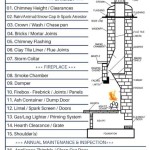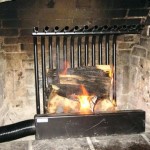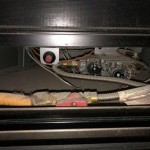Three-Sided Glass Wood Burning Fireplace: A Comprehensive Overview
The three-sided glass wood burning fireplace represents a significant evolution in fireplace design, offering expansive views of the fire while maintaining the traditional appeal and warmth of wood combustion. These fireplaces are also known as peninsula fireplaces. This type of fireplace provides a unique aesthetic element and can serve as a focal point in interior spaces, offering enhanced visual access to the fire from multiple angles. This article will explore the key aspects of three-sided glass wood burning fireplaces, including their design considerations, functional advantages and disadvantages, installation requirements, and maintenance needs.
Design and Aesthetic Considerations
The primary distinguishing feature of a three-sided glass wood burning fireplace is its multi-faceted glass enclosure. This design allows for a panoramic view of the flames, creating a dramatic visual impact that is significantly greater than that of traditional single-sided or even two-sided fireplaces. The design can be incorporated into various architectural styles, from modern minimalist to rustic traditional. The surrounding materials, such as stone, brick, or metal, can be selected to complement the existing decor and enhance the overall aesthetic appeal of the room. The three-sided design frequently serves as a natural room divider, visually separating spaces while maintaining an open and airy feel.
The dimensions of the glass panels are crucial to the overall design. Larger panels provide a more expansive view but may require thicker glass and a more robust structural framework to ensure safety and stability. The frame surrounding the glass can be customized in various finishes, including black, stainless steel, or painted to match the surrounding walls. Some models feature frameless glass, which further minimizes visual obstructions and maximizes the viewing area of the fire. The shape of the fireplace itself can also vary, ranging from rectangular and square to more unconventional shapes, allowing for greater design flexibility.
The placement of a three-sided fireplace within a room is a critical design consideration. It is often positioned to be visible from multiple seating areas or as a central architectural element that draws the eye. When planning the fireplace's location, it's important to consider the flow of traffic and ensure that the fireplace does not obstruct movement or create a safety hazard. The surrounding area should be designed to provide adequate clearance from combustible materials, adhering to relevant building codes and manufacturer recommendations.
Functional Advantages and Disadvantages
The core advantage of a three-sided glass wood burning fireplace lies in its unparalleled visual appeal. The panoramic view of the fire creates a warm and inviting ambiance, enhancing the overall atmosphere of the room. The increased visibility of the flames allows for a more immersive and engaging experience, making it a popular choice for homeowners seeking to create a cozy and comfortable living space. The extended view can make the fireplace a visual anchor in the room, making even a large room feel more intimate.
Beyond aesthetics, these fireplaces offer the practical benefits of wood burning heat, creating a supplemental heat source especially appreciated in colder climates. When equipped with efficient combustion technology and air control systems, they can provide effective and cost-efficient heating. Many modern models incorporate features such as catalytic combustors and airtight doors, which improve combustion efficiency, reduce emissions, and enhance heat output.
Despite the advantages, there are potential drawbacks to consider. Three-sided glass wood burning fireplaces tend to be more expensive than traditional fireplace designs due to the increased complexity of the construction and the higher cost of materials. The installation process is also more challenging and time-consuming, often requiring specialized expertise. The larger glass surface area can contribute to heat loss through radiation, potentially reducing the overall heating efficiency of the fireplace, although modern designs incorporating insulated glass mitigate this issue to some extent.
Cleaning the glass panels is another aspect to consider. The glass tends to accumulate soot and creosote during combustion, which can obscure the view of the fire. Regular cleaning is necessary to maintain the clarity of the glass and ensure optimal visibility. The glass panels' size and configuration can make cleaning more difficult compared to a traditional fireplace with a smaller glass surface. Furthermore, the operation of any wood-burning appliance creates particulate matter, both inside the home and released through the chimney. Proper ventilation and adherence to best-practice burning methods are essential to minimize these effects.
Installation Requirements and Safety Standards
Installing a three-sided glass wood burning fireplace is a complex process that requires careful planning and adherence to building codes and manufacturer specifications. A professional installation is highly recommended to ensure safety and optimal performance. The structural integrity of the surrounding walls and flooring must be assessed to ensure they can support the weight of the fireplace and chimney system. The fireplace and chimney system must be properly sized to ensure adequate draft and prevent the backflow of smoke and gases into the building.
The installation must comply with local building codes and regulations, which often specify minimum clearances from combustible materials. Clearances must be maintained from walls, ceilings, and floors to prevent the risk of fire. Proper insulation and fireproofing are essential to protect the surrounding structure from the intense heat generated by the fireplace. The chimney system must be installed correctly to ensure proper venting of combustion gases. This often involves installing a properly sized chimney liner and following manufacturer recommendations for chimney height and termination.
Safety glass is a critical component of a three-sided wood burning fireplace. Tempered glass or ceramic glass must be used to withstand the high temperatures generated by the fire. The glass must be securely mounted within the frame to prevent it from cracking or shattering. Many modern fireplaces incorporate safety features such as thermal barriers and automatic shut-off mechanisms to prevent overheating and reduce the risk of accidents. It is vital to install carbon monoxide detectors in the vicinity of the fireplace to provide an early warning in case of carbon monoxide leakage.
Regular inspections of the fireplace and chimney system are necessary to ensure they are functioning correctly and safely. A qualified chimney sweep should inspect the chimney annually to remove creosote buildup and identify any potential problems. The fireplace should be inspected for cracks, leaks, or other signs of damage. The seals around the glass panels should be inspected to ensure they are intact and preventing the leakage of smoke and gases. A professional inspection can help identify potential hazards and ensure that the fireplace is operating safely and efficiently.
Chimney and Ventilation Considerations
The chimney is a critical component of a wood-burning fireplace system, responsible for safely venting combustion gases from the fireplace to the outside. The chimney must be properly sized and constructed to ensure adequate draft and prevent the backflow of smoke and gases into the building. The chimney's height must be sufficient to create the necessary draft, and it must be properly insulated to prevent heat loss and condensation. Building codes often specify minimum chimney heights based on the roof's height and proximity to surrounding structures.
The chimney liner is another essential element of the chimney system. The liner protects the chimney from the corrosive effects of combustion gases and prevents the escape of dangerous gases into the building. Stainless steel liners are a popular choice due to their durability and resistance to corrosion. Clay tile liners are another option, but they are more prone to cracking and deterioration. The chimney liner must be properly installed and sealed to ensure its effectiveness.
Proper ventilation is essential for a safe and efficient wood-burning fireplace system. Adequate airflow is necessary to support combustion and prevent the buildup of carbon monoxide. The fireplace should be equipped with an adjustable air inlet to control the amount of air entering the firebox. This allows the user to regulate the burn rate and heat output of the fireplace. In some cases, an external air intake may be required to ensure an adequate supply of fresh air, particularly in tightly sealed homes.
The selection and storage of firewood are also important factors to consider. Only seasoned wood should be burned in the fireplace, as green wood contains a high moisture content that reduces combustion efficiency and increases the production of smoke and creosote. Firewood should be stored in a dry, well-ventilated area away from the house to prevent the growth of mold and insects. It is also important to avoid burning treated wood, which can release harmful chemicals into the air.
Maintenance and Cleaning
Regular maintenance and cleaning are essential for ensuring the safe and efficient operation of a three-sided glass wood burning fireplace. The glass panels should be cleaned regularly to remove soot and creosote buildup. Specialized glass cleaners designed for fireplaces are available and should be used according to the manufacturer's instructions. Avoid using abrasive cleaners or scouring pads, which can scratch the glass. A soft cloth or paper towel is sufficient for removing most soot and creosote. For stubborn stains, a mixture of vinegar and water can be effective.
The firebox should be cleaned regularly to remove ash and debris. Ash can accumulate quickly and reduce the efficiency of the fireplace. Use a shovel and brush to remove ash from the firebox, and dispose of it in a metal container. Be sure to allow the ash to cool completely before disposing of it, as hot embers can pose a fire hazard. The grate should also be cleaned periodically to remove any buildup of ash or creosote.
The chimney should be inspected and cleaned annually by a qualified chimney sweep. A chimney sweep will remove creosote buildup from the chimney liner and identify any potential problems, such as cracks or leaks. Creosote is a highly flammable substance that can accumulate in the chimney and pose a significant fire hazard. Regular chimney cleaning is essential for preventing chimney fires. During the inspection, the chimney sweep will also check the condition of the chimney cap and damper and make any necessary repairs.
The fireplace should also be inspected regularly for any signs of damage or wear. Check the seals around the glass panels to ensure they are intact and preventing the leakage of smoke and gases. Inspect the firebox for cracks or other signs of damage. Check the condition of the damper and ensure it is operating smoothly. If any problems are detected, they should be addressed promptly to prevent further damage and ensure the safe operation of the fireplace.

3 Sided Glass Open View Wide Angle Fireplace By Kfd Smokey Mountain Fireplaces

3 Sided Glass Wood Burning Stoves Forestry Reviews

Luxury Rais 600 3 Three Sided Wood Burning Insert Robey S

Axis Epi950 Three Sided Wood Fireplace Heating Cooling Fireplaces Bbqs Mornington

Axis Epi950 Three Sided Wood Heater Sculpt Fireplace Collection

3 Sided Fireplace Insert Premium A U 70h Spartherm The Fire Company Wood Burning

3 Sided Glass Wood Burning Stoves Forestry Reviews

Woodburning Two Three Sided Fires At Fenton

Rais Three Sided Woodburner Installed In Cornwall Wood Burning Stove Installation From Kernow Fires

Heatilator 42 Inch Three Sided Wood Burning Fireplace








